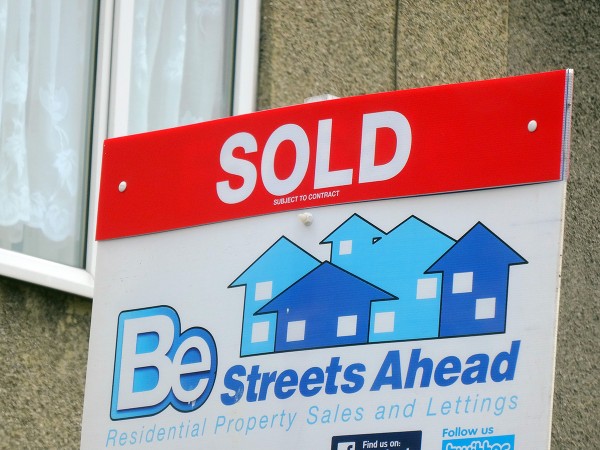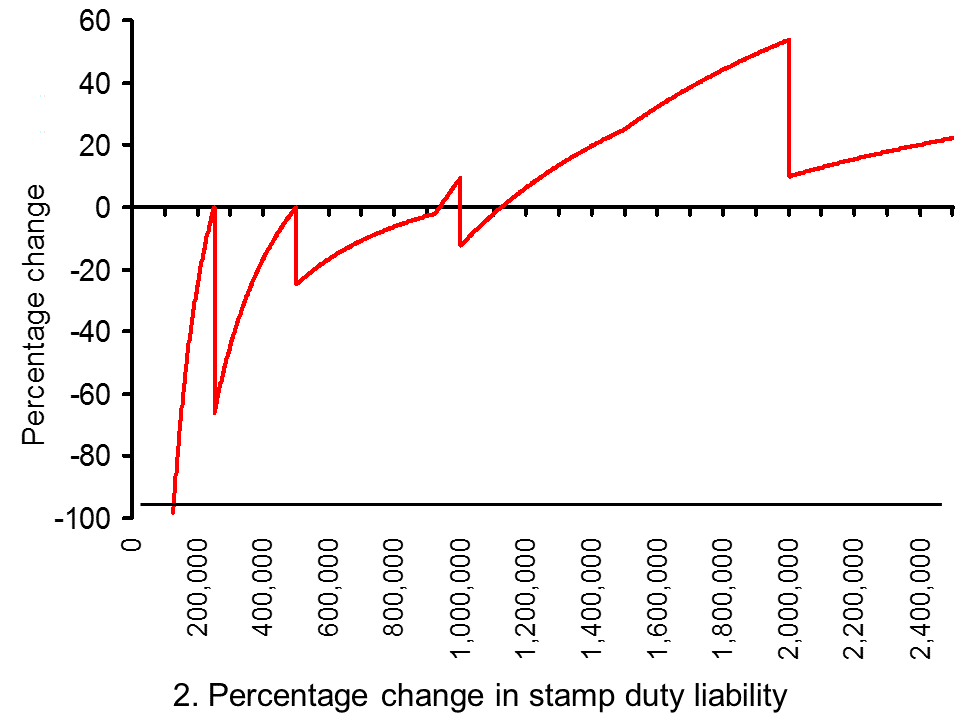 As we reported in New Build: Foundations for a successful housing policy? the Autumn Statement heralded significant reforms to Stamp Duty – the UK tax on house purchases. The result is the introduction of a graduated system of tax, along the lines of the income tax system. A similar regime will continue to operate in Scotland when the Land and Buildings Transactions Tax replaces Stamp Duty next April. Here we consider the impact on the effective rates of tax following the changes to Stamp Duty.
As we reported in New Build: Foundations for a successful housing policy? the Autumn Statement heralded significant reforms to Stamp Duty – the UK tax on house purchases. The result is the introduction of a graduated system of tax, along the lines of the income tax system. A similar regime will continue to operate in Scotland when the Land and Buildings Transactions Tax replaces Stamp Duty next April. Here we consider the impact on the effective rates of tax following the changes to Stamp Duty.
Under the old system any house purchase involving a property whose value was £125,000 or less incurred no Stamp Duty liability. Thereafter, one of five tax rates applied: 1% above £125,000 to £250,000, 3% above £250,000 to £500,000, 4% above £500,000 to £1m, 5% above £1m to £2m and 7 per cent for properties over £2m. The important point was that the whole of the purchase price was subject to one of these five progressively higher tax rates.
The new system sees the introduction of a graduated system of tax which means that the amount paid by house purchasers will be dependent upon the proportion of the value of the property that falls in each of the tax bands. Again, for properties up to £125,000 there will be no liability. There will then be four bands: 1% above £125,000 to £250,000, 5% above £250,000 up to £925,000, 10% above £925,000 up to £150,000 and 12% above £150,000.
One significant impact of the changes is that the liability will be more proportionate to the value of the property. To see this we can compare the average rate of tax under the new and old tax system. The average rate of tax is simply the amount of the tax liability relative to the price of the property.
 From Chart 1 we can see how the new average rate of tax under rises progressively with the price of the property. (Click here to download a PowerPoint of the chart). Under the old system, the profile of the average rate of tax looks like a series of steps with a slab at each tax rate. Unsurprisingly, the system was sometimes referred as the ‘slab system’.
From Chart 1 we can see how the new average rate of tax under rises progressively with the price of the property. (Click here to download a PowerPoint of the chart). Under the old system, the profile of the average rate of tax looks like a series of steps with a slab at each tax rate. Unsurprisingly, the system was sometimes referred as the ‘slab system’.
A second significant change will be the removal of the significant spikes in the marginal rate of tax around each of the tax bands. For example, the tax liability on a property costing £125,001 was £1,250.01 compared with a zero liability on a property costing £125,000. Therefore, a £1 rise in the price of property was accompanied by a £1,250.01 rise in the purchase tax. In percentage terms this is a marginal rate of tax of 125,001. Chart 1 shows how the marginal rates now match the progressively higher tax rates that become payable between each threshold.
The principle of removing the significant distortions to pricing created by the old system of Stamp Duty is likely to receive general approval. However, there may be some unease around the short-term implications for house prices of the bands and rates under the new system. This is largely because nobody purchasing a property at £937,000 or less will see their tax liability rise. The reduction in the liability raises concerns about a potential boost to house prices.
 Chart 2 show the percentage change in the Stamp Duty liability for properties of up to £2.5 million. (Click here to download a PowerPoint of the chart.) The average UK house price, excluding London, is currently £235,000. The stamp duty saving in this case is £150 or 6.4 per cent.
Chart 2 show the percentage change in the Stamp Duty liability for properties of up to £2.5 million. (Click here to download a PowerPoint of the chart.) The average UK house price, excluding London, is currently £235,000. The stamp duty saving in this case is £150 or 6.4 per cent.
But there are more significant savings than this from the reforms, including in London where inflationary pressures in the housing market have been more significant. Here annual price inflation ran at close to 20 per cent in the second and third quarters of the year. Given that the average house price in London is currently £510,000, this means a Stamp Duty saving of £4,900 or 24 per cent. Of course, for premium London markets (and other similar markets elsewhere) a quite different effect could arise. The liability on a £2m property rises by 53.75 per cent. Nonetheless, for most markets it is the boost to prices that is most concerning.
In the East Midlands, which is a good barometer of the market in the rest of the country, there will be a saving of £610 or 32 per cent on the current average property purchase of £189,000. Therefore, even in markets where house price inflation is more subdued there is the potential that the changes to the Stamp Duty system will, in the short term at least, boost housing demand and fuel house price growth.
Stamp Duty/Land and Buildings Transactions Tax
Rates and allowances: Stamp Duty Land Tax Gov.UKLand and Buildings Transaction Tax Revenue Scotland
Autumn Statement
Autumn Statement: documents Gov.UK
Articles
The home owners cashing in on stamp duty reforms Telegraph, Dan Hyde (2/12/14)
Christmas comes early for estate agents after stamp duty changes Guardian, Nigel Bunyan (7/12/14)
Stamp duty: House price boom and mansion bust Telegraph, Anna White (6/12/14)
£200m house deal stampede by wealthy to beat stamp duty hike: Reforms spark one of busiest periods for estate agents in 25 years Daily Mail Online, Louise Eccles and Ruth Lythe (5/12/14)
Stamp duty changes boost housing market and push up prices Guardian, Hilary Osborne (5/12/14)
Stamp Duty revamp blow to SNP property tax reforms Scotsman, Tom Peterkin and Jane Bradley (4/12/14)
 Autumn Statement: What do stamp duty changes mean? BBC News, (3/12/14)
Autumn Statement: What do stamp duty changes mean? BBC News, (3/12/14)
Data
House Price Indices: Data Tables Office for National Statistics
Questions
- What is the tax base of Stamp Duty and the Land and Buildings Transaction Tax?
- How does Stamp Duty distort choices?
- Under the old Stamp Duty system, why might a seller be reluctant to put their property on the market at £251,000?
- What is meant by the average and marginal rates of tax?
- What is meant by a progressive tax?
- What is the connection between the average rate of tax and how progressive a tax is?
- Calculate the marginal rates of tax (in percentage terms) under the old Stamp Duty system following a £1 rise which results in a property’s value moving into the next tax band (start with a £1 rise from £125,000 to £125,001).
- Using a demand-supply diagram show the effect of the Stamp Duty reforms on house prices in most UK housing markets. What characteristics of supply would make the change in price particularly large?
- Are there any housing markets where demand could fall following the introduction of the reforms to Stamp Duty? Illustrate the possible effects using a demand-supply diagram.
- How might an economist go about evaluating the Stamp Duty reforms? What factors will affect the judgement formed?
 As Leicester City celebrated promotion to the English Premier League (EPL) last Saturday (5th April) it also became the first club in England that will probably have to pay a new Financial Fair Play (FFP) Tax. This tax is not paid to the government, but is effectively a fine imposed by the English Football League (EFL) on teams who break FFP regulations.
As Leicester City celebrated promotion to the English Premier League (EPL) last Saturday (5th April) it also became the first club in England that will probably have to pay a new Financial Fair Play (FFP) Tax. This tax is not paid to the government, but is effectively a fine imposed by the English Football League (EFL) on teams who break FFP regulations.
On Tuesday 8th April 2014 representatives from all the Championship clubs met with officials from the English Football League (EFL) in order to discuss the implementation of FFP. It had been reported in February that a number of teams were unhappy about the implementation of the FFP rules and were threatening to take legal action against the league. Unsurprisingly, one of these clubs was rumoured to be Leicester City.
In April 2012, 21 out of the 24 clubs in the Championship agreed on a set of new FFP regulations. These rules place a limit on the size of any financial losses that a team can incur in a given season before punishments, such as a tax, are imposed on them. The English Football League (EFL) stated that the aim of the FFP regulations was to
reduce the levels of losses being incurred at some clubs and, over time, establish a league of financially self-sustaining professional football clubs.
Under the agreed set of rules, all teams in the Championship have to provide a set of annual accounts by 1st December for the previous season: i.e. the first reporting period was in December 2012, when clubs had to submit accounts for 2011–12. No penalties were applied for the first two reporting periods as teams were given time to adjust to the new FFP framework. However sanctions come into effect for the 2013–14 season.
For the 2013–14 season the FFP rules set a threshold of £3 million as the size of the pre-tax financial losses that a team can incur before having to face any sanctions. If a team incurs a pre-tax loss of greater than £3 million but less than £8 million then punishments from the league can be avoided if the team’s owner invests enough money into the club so that the loss is effectively limited to £3 million: i.e. if the club reports a loss of £7 million then the owner would have to invest a minimum of £4 million of his/her own cash to avoid any sanctions.
The club is not allowed to finance the loss by borrowing or adding to the level of the team’s debt. If the owner cannot/refuses to make the investment or the pre-tax loss is greater than £8 million then the team is subject to one of two possible sanctions depending on whether it is promoted or not.
First, if the club is not promoted to the EPL, then it is subject to a transfer ban from the 1st January 2015: i.e. it will be unable to sign new players at the start of the transfer window. The ban remains in place until the club is able to submit financial information that clearly shows that it is meeting the FFP guidelines.
Second, if the club is promoted to the EPL then instead of a transfer embargo it has to pay the FFP Tax. The amount of tax the firm has to pay to the league depends on the size of the financial loss it has incurred. The larger the loss, the greater the tax it has to pay. The marginal rate of tax also increases with the size of the loss.
 In order to help illustrate how the tax works it is useful to take a simple example. Leicester city reported a pre-tax loss of £34 million in 2012–13. If the club managed to reduce its pre-tax losses to £15 million in 2013–14 then, given its promotion, it would be subject to the tax. If we also assume that the owners are willing and able to invest £5 million of their own money into the club then the rate of tax the team would have to pay is based on the size of its losses over £8 million in the following way:
In order to help illustrate how the tax works it is useful to take a simple example. Leicester city reported a pre-tax loss of £34 million in 2012–13. If the club managed to reduce its pre-tax losses to £15 million in 2013–14 then, given its promotion, it would be subject to the tax. If we also assume that the owners are willing and able to invest £5 million of their own money into the club then the rate of tax the team would have to pay is based on the size of its losses over £8 million in the following way:
1% on losses between £8,000,001 and £8,100,000
20% on losses between £8,100,001 and £8,500,000
40% on losses between £8,500,001 and £9,000,000
60% on losses between £9,000,001 and £13,000,000
80% on losses between £13,000,001 and £18,000,000
100% on any losses over £18,000,000
Therefore with a loss of £15 million the FFP tax that Leicester would have to pay is £4,281,000 (£1,000 + £80,000 + £200,000 + £2.4million + £1.6million). If the club instead made a pre-tax financial loss of £30,000 in the 2013–14 season, then the FFP tax it would have to pay increases to £18,681,000 (£1,000 + £80,000 + £200,000 + £2.4million + £4 million + £12 million).
It was originally agreed that the revenue generated from the FFP tax would be shared equally by the teams in the Championship who managed to meet the FFP regulations. However the EPL objected to this provision and the money will now be donated to charity by the EFL.
Based on the financial results reported in 2012–13, about half the clubs in the Championship would be subject to either a transfer ban or FFP tax in January 2015. It was reported in the press in February that a number of clubs had instructed the solicitors, Brabners, to write to the EFL threatening legal action.
One particular concern was the ability of the clubs in the Championship subject to FFP rules to compete with teams relegated from the EPL. When the original FFP regulations were agreed, the teams relegated from the EPL received parachute payments of £48 million over a 4-year period. Following the record-breaking TV deal to broadcast EPL games, the payments were increased to £59 million for the 2013–14 season.
Following the meeting on Tuesday 8th April a spokesman from the EFL said
Considerable progress was achieved on potential improvements to the current regulations following a constructive debate between the clubs.
It will be interesting to see what changes are finally agreed and the implications they will have for the competitive balance of the league.
Articles
Why Championship clubs are crying foul over financial fair play The Guardian (26/2/14)
Wage bills result in big losses at Leicester City and Nottingham Forest The Guardian (5/3/14)
Financial fair play: Championship clubs make progress on talks BBC Sport (10/4/14)
Financial Fair Play in the Football League The Football League (25/4/12)
Loss leaders – Financial Fair Play Rules When Saturday Comes (25/4/12)
Richard Scudamore: financial fair play rules unsustainable in present form The Guardian (14/3/14)
Questions
- To what extent do you think that the implementation of the FFP regulations will either increase or decrease the competitive balance of the Championship?
- An article in the magazine ‘When Saturday Comes’ made the following statement “Last season’s champions, QPR, lost £25.4m and would have been handed a ‘tax’ of at least £17.4m based on 2013-14 thresholds”. Explain why this statement is not accurate. What mistake has the author made when trying to calculate the level of FFP tax payable?
- Nottingham Forest reported pre-tax financial losses of £17 million in 2012-13. If they made the same losses in 2013-14 and were promoted to the EPL, calculate how much FFP tax they would have to pay under current regulations.
- To what extent do you think that the money generated by the FFP tax should be equally distributed between the teams in the Championship who meet the FFP regulations.
- Why do you think team owners might need regulations to restrict the level of losses that they can make. Why might sport be different from other sectors?
 As we reported in New Build: Foundations for a successful housing policy? the Autumn Statement heralded significant reforms to Stamp Duty – the UK tax on house purchases. The result is the introduction of a graduated system of tax, along the lines of the income tax system. A similar regime will continue to operate in Scotland when the Land and Buildings Transactions Tax replaces Stamp Duty next April. Here we consider the impact on the effective rates of tax following the changes to Stamp Duty.
As we reported in New Build: Foundations for a successful housing policy? the Autumn Statement heralded significant reforms to Stamp Duty – the UK tax on house purchases. The result is the introduction of a graduated system of tax, along the lines of the income tax system. A similar regime will continue to operate in Scotland when the Land and Buildings Transactions Tax replaces Stamp Duty next April. Here we consider the impact on the effective rates of tax following the changes to Stamp Duty. From Chart 1 we can see how the new average rate of tax under rises progressively with the price of the property. (Click here to download a PowerPoint of the chart). Under the old system, the profile of the average rate of tax looks like a series of steps with a slab at each tax rate. Unsurprisingly, the system was sometimes referred as the ‘slab system’.
From Chart 1 we can see how the new average rate of tax under rises progressively with the price of the property. (Click here to download a PowerPoint of the chart). Under the old system, the profile of the average rate of tax looks like a series of steps with a slab at each tax rate. Unsurprisingly, the system was sometimes referred as the ‘slab system’.  Chart 2 show the percentage change in the Stamp Duty liability for properties of up to £2.5 million. (Click here to download a PowerPoint of the chart.) The average UK house price, excluding London, is currently £235,000. The stamp duty saving in this case is £150 or 6.4 per cent.
Chart 2 show the percentage change in the Stamp Duty liability for properties of up to £2.5 million. (Click here to download a PowerPoint of the chart.) The average UK house price, excluding London, is currently £235,000. The stamp duty saving in this case is £150 or 6.4 per cent.  Autumn Statement: What do stamp duty changes mean? BBC News, (3/12/14)
Autumn Statement: What do stamp duty changes mean? BBC News, (3/12/14)
